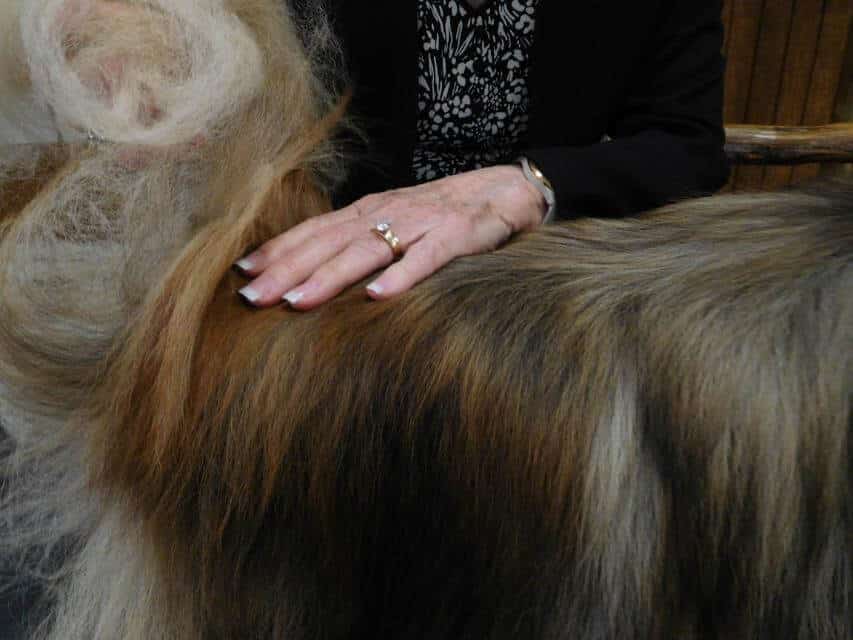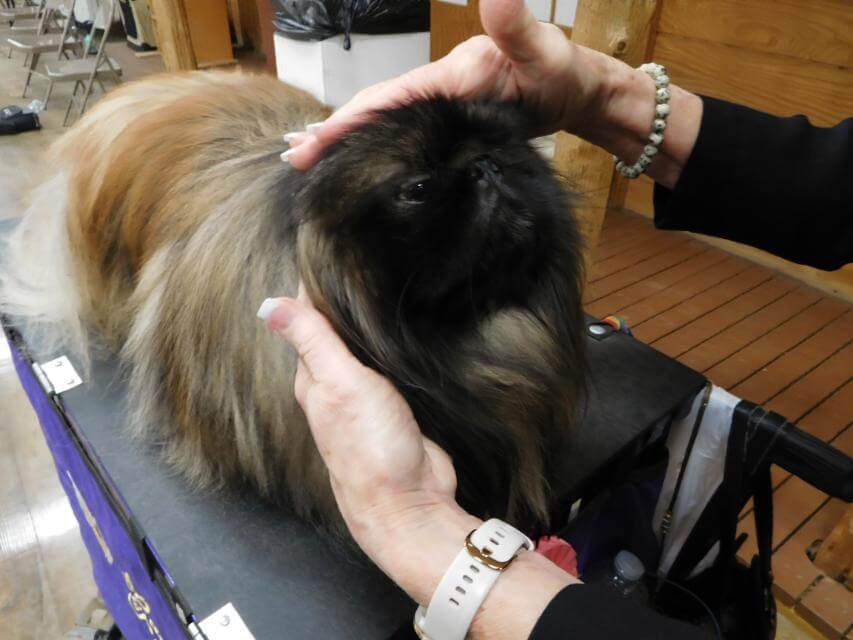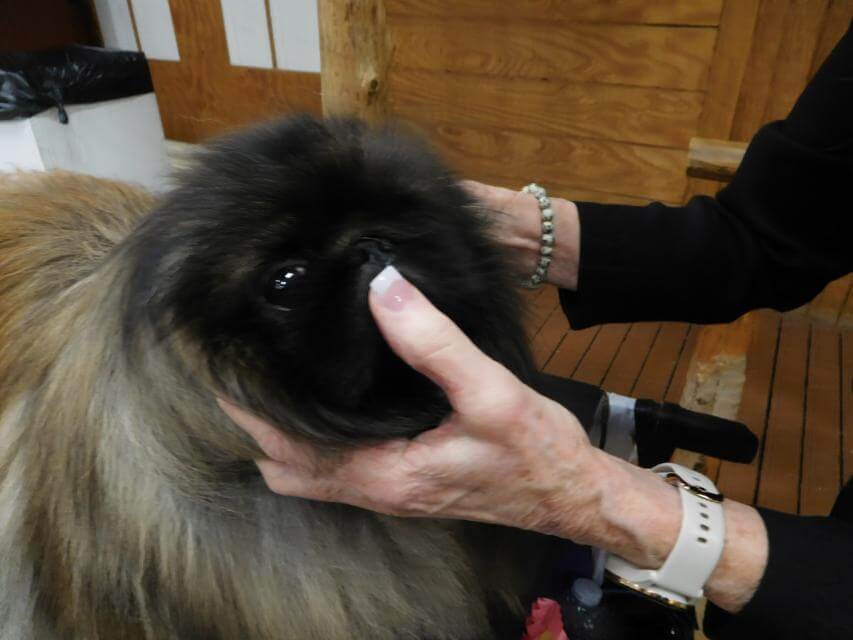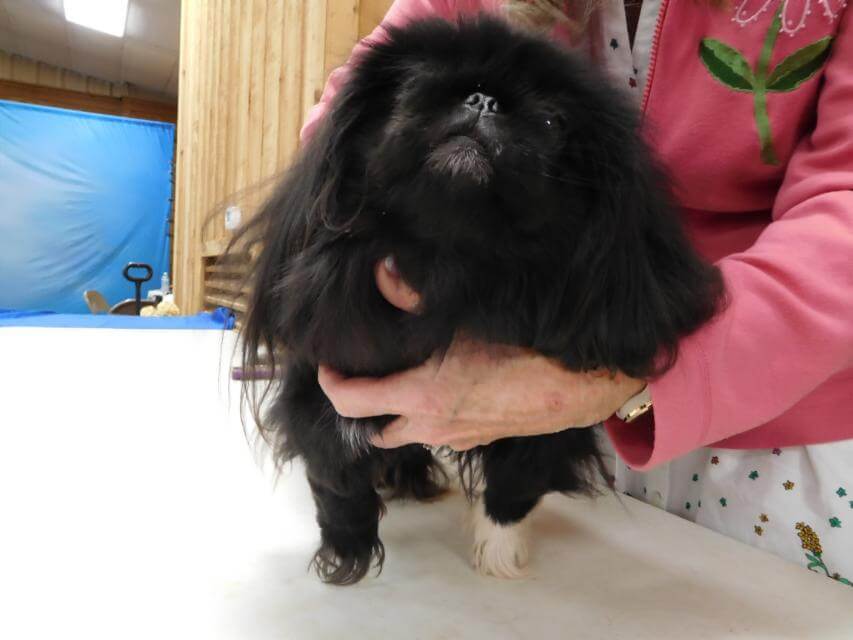


Home » Judging the Pekingese From the Perspective of a Breeder-Judge

(Photographs by Colleen Skinner, Pekingese Club of America Board Member)
Thanks to Judge Nancy Simmons for her help in showing the correct way to judge the Pekingese.
Judging the Pekingese is not a straightforward task—it requires a practiced eye and steady hand. These dogs possess unique physical attributes, with their distinct build, atypical movement, and the presence of a solid, heavy body beneath their luxurious coat. To evaluate them accurately, judges must have a keen understanding of the breed’s specific characteristics, including proper lifting techniques to assess their weight distribution.

The first assessment typically begins with a side view, where the judge evaluates the Pekingese’s overall balance and dignity. This breed should appear compact, short, and well-balanced, radiating a sense of grace and intelligence. The head should be held erect, with a flat profile. The ears should have long, profuse feathering, while the coat must be harsh, long, and straight, supported by a soft, fluffy undercoat. A generous mane around the neck should resemble a cape. The tail should curve slightly over the back, also adorned with long feathering.

The judge will next observe the dog’s movement as it moves around the ring. The Pekingese’s gait is distinctive, characterized by a smooth, rolling motion. The majority of the dog’s weight is carried at the front, with a broad, heavy chest positioned between the forelegs. The hindquarters, with their lighter, straighter legs, propel the dog forward. This forward motion should be smooth, never abrupt or choppy.
Like any Toy breed evaluation… “entries are examined on the table and judged in the floor.”

A table examination allows the judge to inspect the Pekingese in greater detail, feeling the structure beneath the coat. The process begins with the head. The Pekingese should have large, round, dark eyes, with no white visible when the dog looks straight ahead. The face should have an envelope shape, wide between the eyes, with the nose positioned high between them, flanked by plush cheeks. The mouth should be directly beneath the nose. The ears should be heart-shaped, level with the flat skull. The nose and mouth leather should be black, with large, open nostrils, and the wrinkle over the nose should form an inverted “V” with a pronounced stop. Importantly, the coat should not obscure the eyes.
The mouth should feature level lips that meet without revealing the teeth or tongue. The lower jaw should be undershot, and this can be assessed by gently running a thumb across the lower lip to feel the jaw’s protrusion. It is incorrect to ask the exhibitor to open the mouth or “show the bite,” as the teeth are not part of the Breed Standard.
As the judge moves down the dog’s pear-shaped body, attention should be paid to the neck, which should be short, and the topline, which should be level. The rib cage should be wide, with a broad, deep chest well slung between the forelegs—not resting on top of them. The shoulders and elbows should be tight and close to the body, while the forelegs should be thick, heavy-boned, and outwardly bowed. The feet should slightly turn out, with moderately long toe fringes forming a roughly pointed shape.

The waist should be narrow, tapering to a slender rear. The hind legs should be set close together and straight, with no hint of cow-hocking or bandy legs. The dog should stand squarely on its feet, avoiding any weight placed on the pasterns.
Once the table examination is complete, the judge should lift the Pekingese to assess its weight distribution. This should be done by wrapping one hand around the dog and under the chest, near the center of gravity, while the other hand firmly holds the front of the chest. The lift should be just high enough to confirm that the dog is heavier in the front than the rear. It is important to lift the dog calmly, ensuring it remains stable and reassured, avoiding any abrupt movements that might startle or unbalance the animal.

The “down and back” portion of the examination allows the judge to observe the dog’s gait in motion. When the dog moves away, the judge can assess the strong, straight drive of the hind legs. When moving toward the judge, the smooth, rolling motion of the shoulders becomes evident. This observation also provides an opportunity to identify any lameness, which may require the dog to be excused.
If the judge wishes to compare the heads or any other characteristic of two exhibits, it is appropriate to ask the exhibitors to place their dogs side by side on the table. It is not correct to require exhibitors to pick up their dogs for such comparisons. Also, if at any point in the examination the judge suspects a dog in the ring is over 14 pounds, which is the only disqualification for the breed, there should be a call for the scale.

By understanding these key points, judges and exhibitors can work together more smoothly, ensuring a positive and efficient experience in the ring while striving for optimal results. With careful attention to detail and respect for the Pekingese’s unique qualities, both parties can ensure that this charming breed is judged fairly and thoroughly.
